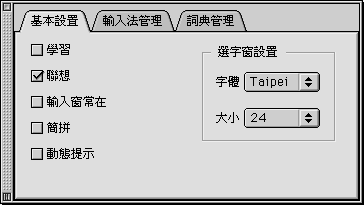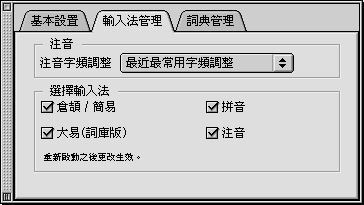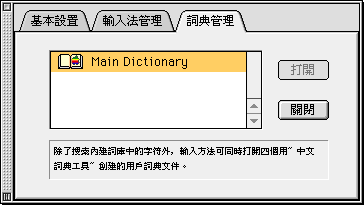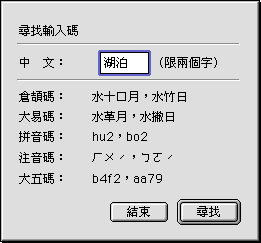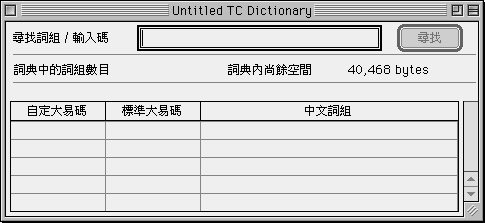Traditional Chinese Input Method (OS 9)
For an introduction the basics of the Apple Chinese input methods, see Getting Started.
Pencil Menu
- Show/Hide Operation Palette: Provides direct access to four of the most common tasks performed by the Pencil menu:

You can choose input modes (top, a pop-up menu), open the Character table (bottom left), open the User Dictionary (bottom center), and open Preferences (bottom right). - Show/Hide Character Table: See below.
- Edit User Dictionary... See below.
- Preferences... See below.
- Reset Default Preferences: Resets everything to the default settings and positions.
- Show Punctuation: Punctuation marks and symbols appear in the Selection window.
- Show User Defined Characters: Enables the use of fonts created by the TrueType Font Editor. To enter characters and define additional input key sequences for them (Big Five hexadecimal codes are automatically assigned), follow these steps:
- Activate the font by putting it into the System folder and restarting your computer.
- Choose the font from the Font menu in the application you are using.
- Choose Show User Defined Characters, and a palette appears. The palette is divided into three horizontal bands:
- Upper: On the left, there is a pop-up menu where you can change fonts. In the center is the character currently selected. Double-click on it to enter it into your document. Listed on the right are the character's input sequences/codes for each of the TCIM input modes.
- Middle: Shows all the characters in the font, with one selected. Point and click to select a different character.
- Lower: Here you can define the input sequences for the selected character. Choose an input mode from the pop-up menu to the left; click on the Dingyi/Xiugai [Define/Revise] button to the right; type the input sequence (you can use the Cangjie, Dayi, Pinyin, and Zhuyin input modes) in the text box that appears.
- Find Input Code: See below.
- Use Two-Byte Roman Characters: Double-width Roman characters align with Chinese text. This is a useful property in certain contexts, such as tables and forms.
- Show Input Keys: Displays input key sequences in parentheses next to the characters in the Selection window. Useful for learning Pinyin tones when you can't remember them. Can also help with learning to use the Cangjie and Zhuyin input modes. The Chinese name for this command is Xuexi, "to learn."
- Show Associated Words: The concept behind this feature is based on a traditional Chinese dictionary, where all words and phrases are found under their first character. When Show Associated Words is active, immediately after you enter a character (by typing its number in the row or by pointing and clicking on it) the Selection window reappears and displays a list of characters that form words or phrases that begin with the character you entered (the first character is not shown in the list, since it already appears inline or in the Input window).
- SoftKeyboard: Displays an image of the keyboard for the active input mode. Can be used as an aid for input by clicking with the mouse or typing on the keyboard.
Preferences
Basic Setup
The Basic Setup [Jiben shezhi] tab, shown below, uses a checklist, where you can click checkboxes to turn commands on or off. The first two also appear in the Pencil menu:
- Show Input Keys [Xuexi]. See above.
- Show Associated Words [Lianxiang]. See above.
- Keep Input Window Open [Shuru chuang chang zai]. Keeps the Input window open after you enter a character.
- Use Simplified Pinyin [Jianpin]. See Input Modes: Pinyin (below).
- Use Dynamic Search [Dongtai tishi]. Clicking this checkbox keeps the Selection window open as you type. For example, in the Pinyin input mode, typing "p" begets all characters that start with p; "pi" narrows the search; and so on.
- Selection Window Settings [Xuanzichuang shezhi]. This is the pair of pop-up menus to the right, which allow you to change the font and size of the text in the Selection window.
Input Method Manager
The Input Method Manager [Shurufa guanli] tab is shown below:
- The upper section contains a pop-up menu for adjusting the Zhuyin character frequency options [Zhuyin zipin tiaozheng]. For details, see Input Modes: Zhuyin (below).
- The lower section allows you to turn the Cangjie, Dayi, Pinyin, and Zhuyin modes on and off. This preserves system memory. If you turn a mode off, after you restart your computer (or log out) you will not be able to choose it from the Pencil menu. To regain access to the mode, turn it back on and restart your computer (or log out).
Dictionary Manager
The Dictionary Manager [Cidian guanli] tab, shown below, controls access to as many as four user-defined dictionaries which can be created using the old Traditional Chinese Dictionary Tool (below). The dictionaries must be in the System: Extensions folder in OS 9 along with the Main Dictionary. You must restart your computer to see them in the Dictionary Manager. Select them and click the Dakai [Open] button (inactive below because the selected dictionary is already open) or the Guanbi [Close] button.
Input Modes
Cangjie
Cangjie is named for the mythic inventor of Chinese characters, Cang Jie. It uses a combination of up to five out of 24 graphic elements to enter the structures of characters. Designed to work in concert with the Show Associated Words feature.
Each element is assigned a key on the keyboard. For more information, see the WayBack Machine: http://www.sungwh.freeserve.co.uk/methods/cangjie.htm
Jianyi
Jianyi is an abbreviated form of Cangjie.
Dayi Pro
Dayi uses sequences of radicals, in an order derived from handwriting rules. Apple has licensed this input mode from a Chinese developer. See: http://www.dayi.com/
Pinyin
Pinyin uses the standard Pinyin phonetic transcription system (except that ü = v) to spell out the standard Mandarin pronunciation of the character. Designed to work in concert with the Show Associated Words feature.
The numbers on the main keyboard can be used to enter tones as long as Dynamic Search is turned off in Preferences. In OS 9 (only), the numeric keypad can always be used to enter tones. For example, you type "ping2" for rising (second) tone ping. Press the space bar and the Selection window will open. Select any character from the list and it will appear immediately inline or in the Input window. Press return or enter to place it in the text of the document.
You can also select Simplified Pinyin [Jianpin] in Preferences. It does not work correctly with Dynamic Search turned on, so make sure it is turned off. Apple's Simplified Pinyin shortcuts are as follows:
- Initials: ch=i; sh=u; zh=a
- Finals: ai=l; an=j; ang=h; ao=k; en=f; eng=g; ing=y; ong=s
Thus, "ping2" would be typed "py2". Certain endings require tones be typed with them. For example, you can't type "pin", you have to type "pin1" or "pin2", and so on. Also, you can't type initials and finals that are abbreviated. For example, you can't type "zhao4", you have to type "aao4", and you can't type "ping2", you have to type "py2".
Zhuyin
Zhuyin uses the 37 Chinese phonetic symbols (bo po mo fo) to spell out the standard mandarin pronunciation of the character. The symbols and the four standard tones are each assigned a key on the keyboard. When you type, the Zhuyin phonetic symbols appear inline or within the Input window. Press the space bar to open the Selection window; select the character you want and enter it inline or in the Input window. Press return or enter to place it in the text of the document.
The Zhuyin input mode is designed to work in concert with the Show Associated Words feature.
Zhuyin input can be adjusted using the Zhuyin Character Frequency Options [Zhuyin zipin tiaozheng] area of Preferences. This is a pop-up menu with four options that specify how Zhuyin displays characters in the Selection window, adjusting the display according to different character frequency options for each particular input key sequence.
- Wu = None
- Jingtai = Static uses the order defined by the input mode.
- Dongtai = Dynamic displays characters according to your frequency of use.
- Zuijin zuichangyong = Most Recent puts the most recent character first, then displays characters according to your frequency of use.
Big Five Code
Big Five Code input requires the four-digit hexadecimal codes of the Big Five character set to enter characters. Just type the code and press return or enter.
Password
Password input is a fix that enables you to enter AppleShare passwords, used for access to servers and workstations. To have your password recognized by AppleShare, you may need to use the Password input mode. If your password is not accepted by the Chooser (and you are sure your username and password were entered correctly), choose the Password input mode and try using the Chooser again.
Character Table
The Character table allows you to see the characters, punctuation marks, and symbols in a given font, as well as their input mode key sequences. It can be minimized, resized, and moved. The current selection is shown in a box in the center of the upper part of the window. Double-click on it to enter it into a document. Listed to the right are its TCIM input mode key sequences. On the left, there are two pop-up menus: the Ziti [Font] menu, where you choose the font that appears in the table, and the Leixing [Category] menu, with four options. The layout of the rest of the Character table depends on which of the four options is selected:
- Radical-stroke table [Bushou bihua biao]. This works like a traditional dictionary, with characters listed by the 214 Kangxi radicals and then by the number of strokes remaining after the radical. Displays the Big Five character set. When this table is selected, the lower part of the window is divided in two:

- Left: Uses a pop-up menu to select the number of strokes in the radical. Scroll, point, and click to select a radical from the list that appears in the window below.
- Right: Lists characters with the selected radical by the number of strokes remaining. Click on the numbered (from 0 to 23+) boxes to display the corresponding list.
- Characters [Hanzi]. Listed by Big Five code.
- Punctuation and Symbols [Biaodian denghao]. Listed by Big Five code.
- Unicode table [Unicode biao]. Listed by Unicode code point. Displays the Big Five character set only.
Utilities
User Dictionary
Edit User Dictionary... in the Pencil menu creates and maintains a preferences document named "Tuser.rem" in the System: Preferences folder. In OS X, it is in your home /Users/~/Library/Preferences folder. The User Dictionary is designed to enable you to create your own custom abbreviations or shorthand translations.
In the Define New Word [Dingyi xinci] dialog box that appears:
- Enter the characters for the word or phrase in the Input New Word [Shuru xinci] text box.
- Then use the Input Encoding [Shuru bianma] text box to type in the Roman (press
caps lockor switch to a Roman keyboard layout) abbreviation or translation you want to use for the input key sequence. No spaces permitted. - Click on the Tianjia [Add] button to enter it into the User Dictionary.
- It then appears listed in the New Word Table [Xinci yilanbiao] window at the bottom of the dialog box.
- To delete a word or phrase from the list, select it and click the Shanchu [Delete] button. When you are done, click the Jieshu [Done] button.
To enter a word or phrase from the User Dictionary into documents, type "U" (for "User") and then the input key sequence you defined for it.
Find Input Code
Allows you to find the input codes for up to two characters. You can copy and paste characters from a document, or input them yourself:
- The button on the right (the default) is Xunzhao [Find].
- The input codes listed are Cangjie, Dayi, Pinyin, Zhuyin, and Big Five.
- When you are done, use the button on the left, Jieshu [Done].
Traditional Chinese Dictionary Tool
The Traditional Chinese Dictionary Tool is an application that allows you to create and edit your own dictionaries for use with the Show Associated Words feature of the TCIM. It is not included with OS 9, but you can download version 1.8 (1998, works in OS 9, but not in OS X Classic) here: TCDT.sit [67 kb download]
The Menu bar has three menus:
- File [Dang'an] menu: Contains (in Chinese) New, Open, Close, Save, Save as..., Revert to Saved, Save as Text File..., and Quit.
- Edit [Bianji] menu: Contains (in Chinese) Undo, Cut, Copy, Paste, Clear, and Select All.
- Dictionary [Cidian] menu:
- Add Word/Phrase... [Zengjia cizu]: Opens the Edit Word/Phrase dialog box. See below.
- Add Words/Phrases from a User-Defined Dictionary... [Cong zidingyi cidian zhong jiaru cizu]: Use this dialog box to add words and phrases to the open dictionary from another dictionary.
- Add Words/Phrases from a Text File... [Cong wenzi dang'an zhong jiaru cizu]: Use this dialog box to add words and phrases to the open dictionary from a text document.
When the application opens, a new "Untitled TC Dictionary" window appears (to edit or add to an existing dictionary, choose Open from the File menu), divided into three horizontal bands:
- The upper band contains a text box, titled Xunzhao cizu/shuru ma [Search for Word/Phrase/Input Sequence], where you can search for a specific word, phrase, or Dayi input key sequence (click the Revise [Xiugai] button after entering the text) in an existing dictionary. When the desired word or phrase is selected, you can double-click on its line in the table to open the Edit Word/Phrase dialog box (see below). To delete, press Delete, or choose "Cut" or "Clear" from the Edit menu. If you change your mind, you can choose "Revert to Saved" from the File menu. Choose "Save as Text File..." from the File menu to save a dictionary's words and phrases and their input codes to a text document.
- The middle band shows the number of words and phrases in the dictionary (on the left) and the amount of free space remaining in the dictionary (on the right).
- The lower portion of the window contains a table with three columns, which indicate:
- User-defined Dayi code [Ziding Dayima]
- Standard Dayi code [Biaozhun Dayima]
- Chinese-Language Words and Phrases [Zhongwen cizu], which shows the Chinese text.
To enter a new word or phrase into a dictionary, choose "Add Word/Phrase..." from the Dictionary menu. This opens the Edit Word/Phrase dialog box [Cizu denglu], as follows:
- Enter the word or phrase in the upper text box.
- The standard Dayi input keys for the phrase appear below the text box, shown in Roman letters.
- In the lower text box, you can define your own abbreviated Dayi input key sequence, limited to four lower-case Roman letters.
- Click the Register [Denglu] button to enter it into the dictionary.
User-defined dictionaries must be in the System: Extensions folder to be available in the Dictionary Manager portion of TCIM Preferences in OS 9. To edit them, they must be inactive (closed). User-defined TCIM dictionaries are not recognized in OS X 10.2.4 and above.

